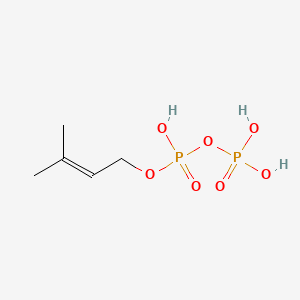| Luo H et al. |
Analysis of the transcriptome of Panax notoginseng root uncovers putative triterpene saponin-biosynthetic genes and genetic markers. |
2011 |
BMC Genomics |
pmid:22369100
|
| Sivy TL et al. |
Evidence of isoprenoid precursor toxicity in Bacillus subtilis. |
2011 |
Biosci. Biotechnol. Biochem. |
pmid:22146731
|
| Artz JD et al. |
Molecular characterization of a novel geranylgeranyl pyrophosphate synthase from Plasmodium parasites. |
2011 |
J. Biol. Chem. |
pmid:21084289
|
| Lu J et al. |
Human ovarian tumor cells escape γδ T cell recognition partly by down regulating surface expression of MICA and limiting cell cycle related molecules. |
2011 |
PLoS ONE |
pmid:21935360
|
| Yeh E and DeRisi JL |
Chemical rescue of malaria parasites lacking an apicoplast defines organelle function in blood-stage Plasmodium falciparum. |
2011 |
PLoS Biol. |
pmid:21912516
|
| Nordqvist A et al. |
Synthesis of functionalized cinnamaldehyde derivatives by an oxidative Heck reaction and their use as starting materials for preparation of Mycobacterium tuberculosis 1-deoxy-D-xylulose-5-phosphate reductoisomerase inhibitors. |
2011 |
J. Org. Chem. |
pmid:21936546
|
| Leonard E et al. |
Combining metabolic and protein engineering of a terpenoid biosynthetic pathway for overproduction and selectivity control. |
2010 |
Proc. Natl. Acad. Sci. U.S.A. |
pmid:20643967
|
| Lim L and McFadden GI |
The evolution, metabolism and functions of the apicoplast. |
2010 |
Philos. Trans. R. Soc. Lond., B, Biol. Sci. |
pmid:20124342
|
| Kiran U et al. |
Structural and functional characterization of HMG-COA reductase from Artemisia annua. |
2010 |
Bioinformation |
pmid:21364776
|
| Dunne MR et al. |
Preferential Th1 cytokine profile of phosphoantigen-stimulated human Vγ9Vδ2 T cells. |
2010 |
Mediators Inflamm. |
pmid:21403900
|
| Hasunuma T et al. |
Metabolic engineering by plastid transformation as a strategy to modulate isoprenoid yield in plants. |
2010 |
Methods Mol. Biol. |
pmid:20552454
|
| George GM et al. |
Virus-induced gene silencing of plastidial soluble inorganic pyrophosphatase impairs essential leaf anabolic pathways and reduces drought stress tolerance in Nicotiana benthamiana. |
2010 |
Plant Physiol. |
pmid:20605913
|
| Goto T et al. |
Various Terpenoids Derived from Herbal and Dietary Plants Function as PPAR Modulators and Regulate Carbohydrate and Lipid Metabolism. |
2010 |
PPAR Res |
pmid:20613991
|
| Kabelitz D |
Human γδ T lymphocytes for immunotherapeutic strategies against cancer. |
2010 |
F1000 Med Rep |
pmid:20948839
|
| Chu HM et al. |
Binding and catalysis of Humulus lupulus adenylate isopentenyltransferase for the synthesis of isopentenylated diadenosine polyphosphates. |
2010 |
FEBS Lett. |
pmid:20807533
|
| Costa GG et al. |
Transcriptome analysis of the oil-rich seed of the bioenergy crop Jatropha curcas L. |
2010 |
BMC Genomics |
pmid:20691070
|
| Thibodeaux CJ et al. |
Linear free energy relationships demonstrate a catalytic role for the flavin mononucleotide coenzyme of the type II isopentenyl diphosphate:dimethylallyl diphosphate isomerase. |
2010 |
J. Am. Chem. Soc. |
pmid:20593767
|
| Connor MR and Atsumi S |
Synthetic biology guides biofuel production. |
2010 |
J. Biomed. Biotechnol. |
pmid:20827393
|
| Dellomonaco C et al. |
The path to next generation biofuels: successes and challenges in the era of synthetic biology. |
2010 |
Microb. Cell Fact. |
pmid:20089184
|
| Kumano T et al. |
Functional characterization of the promiscuous prenyltransferase responsible for furaquinocin biosynthesis: identification of a physiological polyketide substrate and its prenylated reaction products. |
2010 |
J. Biol. Chem. |
pmid:20937800
|
